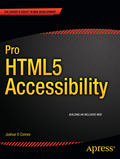This blog is a review/response to the recent MSDN article Designing Accessibility with HTML5 by Rajesh Lal (@irajlal). The article is quite extensive and covers an intro to accessibility and disability, progressive enhancement, ARIA, forms, tables, and more.
I had actually reviewed an early version of this article, but it seems some of my feedback was not incorporated, and there is also some new content in the article. So let’s discuss some of those items and more.
The introduction does an adequate job of covering the four main types of disabilities: hearing, mobility, cognitive, and visual. For reference, here’s the link to the WCAG 2.0 POUR model (perceivable, operable, understandable, robust) as mentioned.
Progressive Enhancement
I was happy that Progressive Enhancement (PE) was mentioned next, early in the article. I firmly believe that semantic markup and PE are essential to a robust and accessible webpage. PE was described fairly well, but then I was disappointed to see example code further down the page which does not use PE. In Figure 9, the form example is missing a URL in the action attribute and contains the following line to submit:
<div><a href="#" onclick="submit()">Send Your Message!</a></div>
This line does not represent proper semantic markup, progressive enhancement, nor the non-JavaScript use case. A better example would be to add a dummy URL in the action attribute, and for the submit button, do this:
<input type="submit" value="Send Your Message!" />
Headings
In Figures 6 and 7, home page sample code, the document outline is broken. The heading order jumps from H2 to H4 so is missing the H3. It also appears that the H4 elements in the aside element are correlated to the last H2, which in incorrect; they are separate topics. To solve, I would insert an H2 heading in the aside element and change the H4 elements to H3. In addition, there is no H1 element.
Figure 11, Markup for a FAQ Page, does indeed provide an ideal heading structure.
A perfect heading structure is not essential, but certainly helps. Especially when the code is an example for other developers.
And for the record, in Figures 6 and 7, the image element for the logo is missing alt text.
JavaScript Insertion
It’s good that the author recommends placing the external JavaScript files at the end of the body (at end of home page section), but remember that you may need to put certain JavaScript at the top, mostly scripts for feature detection such as Modernizr. (This isn’t really accessibility but thought I’d include anyway.)
Fieldset/Legend
In the Contact Form section, I really like that the sample code is using the placeholder attribute correctly. But there’s one issue; the fieldset element is being used but the legend is missing. The spec oddly says legend is optional, but it’s definitely best practice to use it. Otherwise, there’s no reason to use fieldset in the first place as far as I know.
Data Table
In the data table, use of a caption element is great, but I’m perplexed as to why there is a details and summary element within the caption. And I wouldn’t recommend using a strong element with the caption text; use CSS instead. Also, the TH elements should have a scope attribute; it may not be necessary with newer assistive technologies, but makes the code more robust and semantic.
Links, titles, and abbreviations
Towards the end of the article, there’s a section on links and images. I really advocate this advice: Use a CSS background image if your design requires an icon such as “>”.
Just before that, I have issues with the sample text link. Avoid “click here” is good, but then the title attribute contains “click for”. This somewhat of a moot point as the title isn’t needed at all. Traditionally, the title attribute is only needed for additional supplementary information (not required for user). The mighty Steve Faulker, in his article Using HTML title attribute, suggests that title only be used in a couple rare cases.
For images, I would not recommend the title attribute here either (due to lack of support). For even more on that, check out this recent article about title attributes on the RNIB site.
About the link underline, of course I agree that text links (in main content especially) should be underlined. The sample CSS adds the underline, but it’s much better to do this by not removing it in the first place. The underline does not have to be added; it should already be there by default.
The abbreviation example is simple and solid, but there’s more to it than that. Because of poor support, the title attribute doesn’t work typically with the keyboard and some assistive technologies (see links above). Therefore, I strongly suggest that the full text of the acronym or abbreviation is written out when it first appears on each page.
Final Thoughts
I don’t have much to say about the audio/video section; I’m just wondering where the keyboard shortcuts listed for the HTML5 media controls comes from.
It’s great to see that Visual Studio 2012 has ARIA support. I know it’s still a popular application, but I don’t have much experience with it myself.
The MSDN article Designing Accessibility with HTML5 has a lot of good information and tips. But many times, especially with accessibility, the devil is in the details. It is quite a tricky topic and there are many nuances and gray areas. I hope this response has cleared up some of those.


